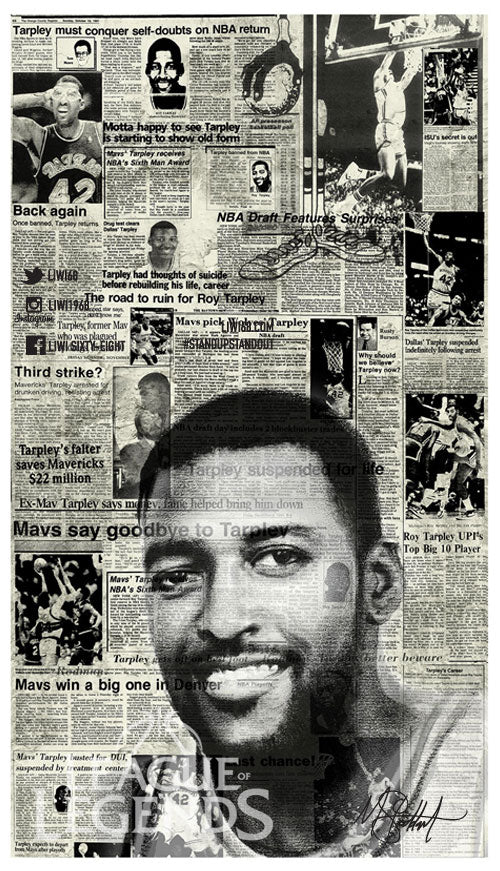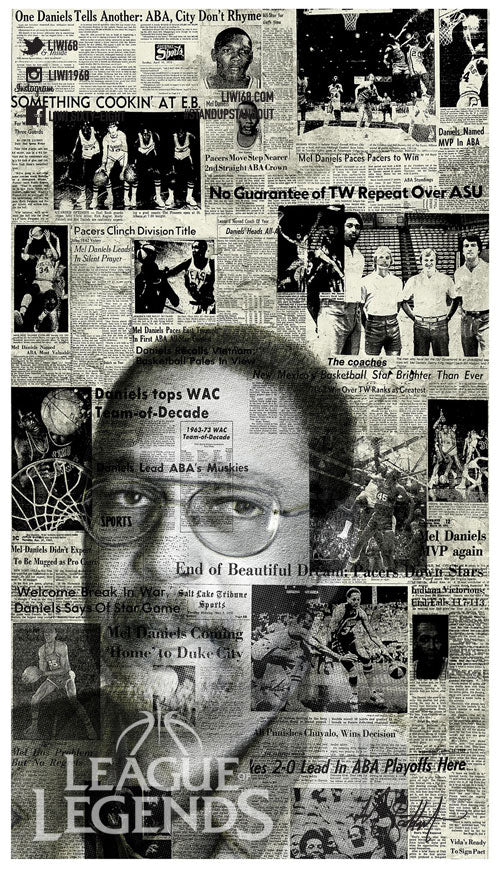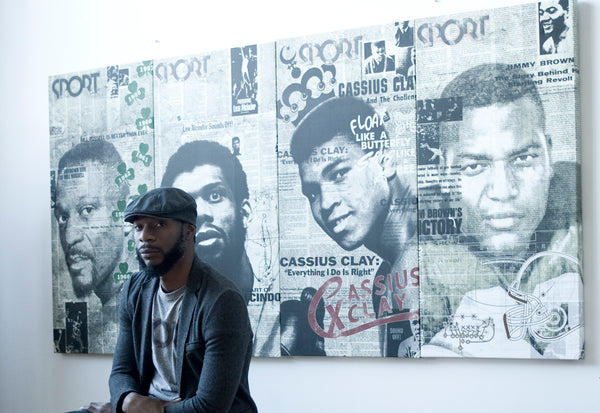- No products in the cart.
“Being an avid NBA fan since the 70s, I watched all of these athletes at some point dominate the hardwood and leave their unique mark on the game of basketball. It is my pleasure and an honor to commemorate their life and accomplishments on canvas.”
– Mark Stoddart
In honour of Toronto aka “The Six” hosting its inaugural NBA All-Star Weekend, and as a token of my appreciation for those athletes that have come before us and who have left their mark on the game of basketball, I bring you my latest collection titled League of Legends. In 2015 the league and basketball fans throughout the world lost eight (greats - whom I consider) legends (Jerome Kersey, Earl Lloyd, Anthony Mason, Darryl Dawkins, Moses Malone, Mel Daniels, John Williams and Roy Tarpley) that evolved and shaped the game of basketball and the way it was played. They played their roles in evolving and shaping the game of basketball and the way it was played.
Eight new art pieces honouring the lives of these athletes will be unveiled each day leading up to All-Star game this coming Sunday.
Each piece is embedded on a archival water color paper comprised of various newspaper articles which I have strategically crafted with a touch of eloquence, eight readable digital prints portraying larger than life images of these legends.
Being an avid NBA fan since the 70s, I watched all of these athletes at some point dominate the hardwood and leave their unique mark on the game of basketball. What’s ironic about all of these players is that they were all power forwards. Power forwards, warriors at their finest, battling in the paint, sacrificing the bodies for their team, demanding respect for the ball. The game of basketball has obviously evolved where today’s power forwards are no longer just bangers in the paint but skilled ball handlers and shooters. Despite the evolution of this position, these power forwards truly defined the game of basketball and paved the way for today’s current players.
The release of this collection also coincides with Black History Month which, in my opinion, is an excellent time to honor these eight great players. It’s also an excellent time to truly reflect on the lives of these athletes as well as many more that have played and continue to play the game.
My hope is that the imagery triggers conversations as we go about our regular routines so that we not forget the impact these gentlemen made to our lives.
As thousands of people start to descend on our great city to take part in the many events and parties that will be happening during All-Star weekend, I’m humbled and happy to share with you this wonderful collection.
With that being said, the Legend of Legends Collection.
Enjoy,
Mark Stoddart
John “Hot Rod” Williams
"As a player, Hot Rod was one of those freak of nature guys who was 6-10, who could shoot the basketball, could put the basketball down on the floor, a very good defensive guy."
- Ron Harper
Williams, better known by the nickname Hot Rod, was a solid shooter and a dogged defender during his 13 seasons in the N.B.A. Listed at 6 feet 11 inches, he played power forward and center with Cleveland.
His nickname came from the engine noises he made while playing with toy cars as a boy, The Plain Dealer of Cleveland reported.
The 6-foot-11 Williams was a completely unselfish player on the court. He loved to defend, block shots and set picks. In his nine seasons, he averaged 13 points and 7.1 rebounds for the Cavs, shooting 48 percent. He could play any spot in the frontcourt.
Although not a Hall of Famer, Williams had a respectable career. He averaged 11 points, 6.8 rebounds, 1.8 assists and 1.6 blocks per game, and his percentages were impressive: a .480 career field-goal average and a .726 free-throw average.
Roy Tarpley

Roy Tarpley was selected by the Dallas Mavericks in the first round, with the seventh pick of the NBA Draft. Tarpley made the NBA All Rookie Team in his first season and won the NBA Sixth Man of the Year Award the following year when he averaged 13.5 points and 11.8 rebounds per game.
Tarpley starred at the University of Michigan. He was named a 3rd-Team All-American by the AP in 1985 and 1986. During the 1984-85 season, Tarpley led the Wolverines to the Big Ten championship, averaging 19.0 points and 10.4 rebounds per game throughout the season which led to him earning the Big Ten Player of the Year award.
Jerome Kersey

Jerome Kersey played 17 years in the NBA for six teams (Portland, Golden State, LA, Seattle, San Antonio and Milwaukee). Prior to getting drafted, Kersey attended Longwood College, a NCAA Division II school, where he set school records for points, rebounds, steals and blocked shots while making 57% of his baskets.
Drafted 46th in the second round by the Portland Trailblazers, Kersey immediately became a fan favorite. By the time his playing career was done with Portland, Kersey was at the top of many of Portland’s career categories which included: games played (2nd), minutes played (3rd), scoring (3rd), rebounding (2nd), assists (6th), steals (3rd), field goals made (4th) and blocked shots (2nd).
Kersey went on to win a championship with the San Antonio Spurs.
Mel Daniels

Mel Daniels was a titan of the ABA. A seven-time All-Star and five-time all-ABA pick (four first-team), Daniels finished at 18.7 ppg and 15.1 rpg. He ranks as the ABA’s all-time leader in rebounds, fourth in points and fourth in minutes.
Daniels won the ABA’s Most Valuable Player Award in 1969 and 1971 and led the Pacers to championships in 1970, 1972 and 1973.
Offensively, Daniels was adept with hook shots with either hand. He had an elusive turnaround jumper and showed good hang time for a man his size (6-foot-9, 220). Defensively, he was tenacious on the boards and in challenging shots, as well as a willing help defender.
Daniel was inducted into the Naismith Memorial Basketball Hall in 2012.
Darryl Dawkins

“Darryl Dawkins is the father of power dunking,” Shaquille O’Neal once said. “I’m just one of his sons.”
Darryl Dawkins, nicknamed “Chocolate Thunder” was known for his powerful dunks, which led to the NBA adopting breakaway rims due to his shattering the backboard on two separate occasions in 1979.
Dawkins went on to name the first backboard-breaking dunk “Chocolate-Thunder-Flying, Robinzine- Crying, Teeth-Shaking, Glass-Breaking, Rump-Roasting, Bun-Toasting, Wham-Bam, Glass-Breaker-I-Am-Jam.”
According to his coach at Maynard Evans High School in Orlando, Dawkins was probably the best high school basketball player ever. At the age of 18, Dawkins renounced his college eligibility and applied for the 1975 NBA draft. The Philadelphia 76ers made him the fifth overall pick.
Dawkins averaged double figures in scoring nine times in his 14 years in the NBA, often ranking among the league leaders in field-goal percentage. He played in the NBA Finals three times a member of the Philadelphia 76ers in the late 1970s and early 1980s.
Following his NBA career, Dawkins had a brief stint with the Harlem Globetrotters, coached the Newark Express as part of the American Basketball Association (ABA), and was also a player/coach of the Winnipeg Cyclone, a team short-lived in the International Basketball Association.
He was inducted into the Naismith Memorial Basketball Hall of Fame in his first year of eligibility in 2001.
Anthony Mason

"We were either gonna win the game or win the fight." -Anthony Mason
Anthony Mason played for six teams during his NBA career but was best remembered for his five year tenure with the New York Knicks. Mason’s bruising, physical play epitomized then coach Pat Riley’s Knicks teams. The 6-foot-7 forward quickly became a fan favorite for his physical play and for the creative artwork and messages carved in his haircuts.
After playing high school basketball at Springfield Gardens in Queens and college basketball at Tennessee State University, Mason was selected in the third round of the 1988 NBA draft by the Portland Trailblazers.
In his 13-year career within the NBA, Mason averaged 10.8 points and 8.3 rebounds. He earned the NBA Sixth Man of the Year Award in 1995 and then led the NBA in minutes played in the subsequent two seasons. In 1997, he earned All-NBA (3rd team) and NBA All Defensive Team (2nd team). In 2001 he was selected to NBA All-Star Game.
Moses Malone

"I never thought I was the best; I just thought I was one of the best." -Moses Malone
You don't need to be better than anyone else; you just need to be better than you used to be. The more you see yourself as what you'd like to become, and act as if what you want is already there, the more you'll activate those dormant forces that will collaborate to transform your dream into your reality.
Moses Malone began his pro career out of high school after he was selected in the third round of the 1974 ABA Draft by the Utah Stars. He was named an ABA All-Star as a rookie and played two seasons in the league until in merged with the NBA in 1976.
He landed in the NBA with the Buffalo Braves who traded him after two games to the Houston Rockets. Malone became a five-time All-Star in six seasons with the Rockets. After leading the NBA in rebounding in 1979, he was named league MVP for the first time. Malone was traded to Philadelphia the following season, where he repeated as MVP and led the 76ers to a championship in his first year.
Malone led the NBA in rebounding six teams, including a record five-straight seasons (1981-1985). He finished his career as the all-time leader in offensive rebounds after leading both the ABA and NBA in the category a combined nine times. Malone was nicknamed “Chairman of the Boards” for his rebounding prowess.
"I never thought I'd lead the NBA in rebounding, but I got a lot of help from my team-mates - they did a lot of missing" -Moses Malone
Earl Lloyd

Was born on April 3, 1928, in Alexandria, Virginia. Nicknamed “The Big Cat”, Lloyd was the first black player to appear in an NBA game in 1950 as a member of the Washington Capitals, just before fellow black players Sweetwater Clifton and Chuck Cooper played their first games.
The 6-foot-5 forward averaged 8.4 points and 6.4 rebounds in 560 regular-season games in nine seasons with Washington, Syracuse and Detroit. He missed the 1951-52 season while serving in the U.S. Army.
Prior to the NBA, Lloyd played collegiate ball at West Virginia State College and led them to two CIAA Conference and Tournament Championships in 1948 and 1949. He was named All-Conference three times (1948-50) and was All-American twice. As a senior, he averaged 14 points and 8 rebounds per game.
In 2003, Lloyd was recognized for his contributions as a player and was inducted into the Naismith Memorial Basketball Hall of Fame.
“I stepped onto the court and the world kept spinning…no one said a word – not the fans, players, anybody. Nothing was ever said about me being the first black. They acted as if I was a player period. I don’t recall any mention in the newspapers about me being the first black to play in an NBA game.”- Earl Lloyd
Lloyd helped the Syracuse Nationals win the 1955 NBA title, joining teammate Jim Tucker as the first black players to play on a championship team.
Artist | Mentor | Activist | Graphic Designer Twitter/Instagram • @liwi68

